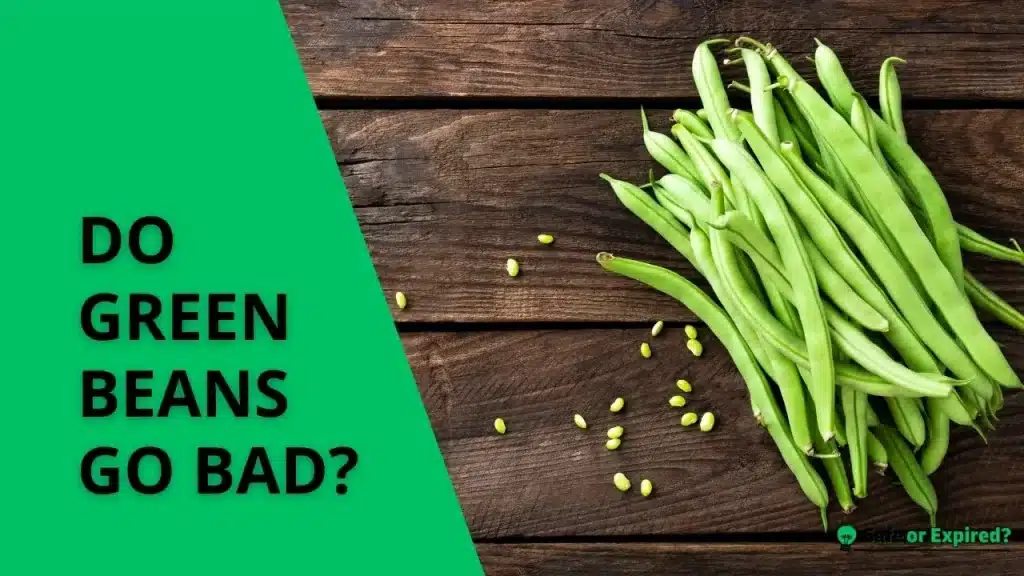“Do green beans go bad?” is a topic often searched by health-conscious individuals. Absolutely, they do get spoiled, and knowing how to spot the signs can save your dinner plans! Here, we’ll explore how to keep them fresh longer and what makes them spoil.
Stick around to become a green bean storage expert, and never toss them out too early again!
Do Green Beans Go Bad?
Yes, green beans can go bad. They typically show signs of spoilage by becoming slimy, discolored, or developing an off smell. When you notice one or all of these signs, it’s better to discard the beans. Also, remember that proper storage can prevent them from going bad prematurely.
People have many questions related to green bean spoilage. Let’s discuss it all.
Do Green Beans Go Bad After Opening?
Once opened, green beans should be stored properly in the refrigerator to prevent spoilage. If you keep the beans in a container or plastic bag, they can maintain freshness for several days. However, always check for signs of spoilage before consumption.
Do Green Beans Go Bad If Left Out?
Green beans left out at room temperature can go bad quickly, especially in warm conditions. Bacteria can attack and spoil the beans within a few hours. It’s best to refrigerate them if they aren’t used immediately. Check out this guide if you want to learn more about spoilage causes: 15 factors That Affect Food Spoilage.
Do Green Beans Go Bad Overnight?
Leaving green beans out overnight is likely to lead to spoilage. Without refrigeration, they become susceptible to bacteria and other pathogens that accelerate decay. To ensure safety and quality, always store green beans in the fridge.
Do Green Beans Go Bad in the Fridge?
Green beans can go bad in the fridge if not stored correctly. Signs of spoilage include a slimy texture, unpleasant odor, or a dull, discolored appearance. To maximize their shelf life, store them in a sealed bag or container in the crisper drawer of your refrigerator.
Do Cooked Green Beans Go Bad in the Fridge?
Cooked green beans can go bad in the fridge if they are not stored properly. They remain fresh for a few days when kept in an airtight container but should be checked for spoilage signs like an off smell or mold before consumption.
But why do green beans go bad in the refrigerator even if you refrigerate them properly? Well, green beans may go bad in the refrigerator due to:
- Excessive moisture leads to mold growth.
- Improper sealing exposes them to air and speeds up decay.
- Cross-contamination from other foods.
- Storing them unwashed with residual soil can harbor pathogens.
People also ask, “Why do green beans turn brown in the fridge?” Green beans can turn brown in the fridge due to enzymatic browning, a natural process accelerated by exposure to air. This can happen if they are not properly sealed or if they have been damaged or bruised before storage, exposing more surface area to air.
Do Green Beans Go Bad in Freezer? Let’s Find Out
Green beans stored in the freezer can remain safe to eat for a long time if they are properly prepared and packaged. However, they can suffer from freezer burn if exposed to air, which affects their texture and flavor but not their safety.
Do Green Beans Go Bad if Frozen?
Green beans do not go bad in the freezer when properly frozen. They can last for several months, retaining most of their quality. To avoid issues like freezer burn or texture changes, ensure they are blanched, dried, and sealed in airtight containers.
How Long Do Green Beans Go Bad? Know the Time
Green beans typically last about 7 to 10 days in the refrigerator. If properly blanched and frozen, they can retain quality for up to 12 months in the freezer. The shelf life of green beans is relatively short in the fridge due to their high moisture content. This makes them susceptible to mold and bacterial growth.
But if you don’t see spoilage signs, then you can go ahead and eat such beans. Here’s what a good-quality green beans should look like:

Freezing extends their lifespan significantly by halting the growth of microorganisms and slowing down enzymatic reactions that cause spoilage. Proper storage methods, such as airtight containers or vacuum-sealed bags, are crucial for maximizing their shelf life.
Do Canned Green Beans Go Bad? Everything to Know
Yes, canned green beans can go bad, but they have a much longer shelf life compared to fresh green beans. When stored properly in a dry place, unopened cans of green beans can last for years beyond their “best by” date without losing quality.
However, once opened, they should be transferred to another container if not used entirely and refrigerated. Under these conditions, they typically last for up to 3 to 5 days. Signs that canned green beans have gone bad include a bulging can, a bad odor upon opening, visible mold, or an off-taste.
Always inspect the can for any signs of damage or unusual appearance before use, as compromised packaging can lead to spoilage.
Here’s a table detailing the shelf life of green beans under various storage conditions:
| Storage Condition | Shelf Life | Notes |
| Fresh, Refrigerator | 7 to 10 days | Store in a ventilated plastic bag in the crisper drawer. |
| Fresh, Room Temperature | 1 to 2 days | Best if used within a day, especially in warm climates. |
| Cooked, Refrigerator | 3 to 5 days | Store in an airtight container to maintain quality. |
| Blanched and Frozen | 8 to 12 months | Blanching before freezing preserves texture and flavor. |
| Canned, Unopened | Up to 5 years | Store in a dry place. Check the can for damage before use. |
| Canned, Opened | 3 to 5 days | Transfer to an airtight container and refrigerate. |
| Pickled, Unopened | Up to 2 years | Store in a cool, dry place. Refrigerate after opening. |
| Pickled, Opened | 1 to 2 months | Keep refrigerated in a sealed container. |
| Dried | Indefinitely | Store in a cool, dry place. Check the can for damage before use. |
How To Know if Green Beans Are Bad? The Signs
You can tell if green beans are bad by looking for several key signs: sliminess, discoloration, and a bad smell. If green beans exhibit any of these characteristics, it’s best to discard them to avoid the risk of consuming spoiled food.
Sliminess
When green beans start to go bad, they often develop a slimy coat. This sliminess is a clear sign that bacteria have begun to grow on the beans. Fresh green beans should feel firm to the touch and snap crisply when bent. If your green beans feel sticky or gooey, it’s time to throw them away. If you don’t, you will see “green beans white insides.”
The presence of slime is a major indicator that they’re no longer safe to eat and have likely begun to decompose. Regularly checking for this can prevent you from using spoiled beans in your cooking.
Discoloration
Keep an eye out for unusual colors on your green beans. They should be a vibrant green. If you see patches of brown, yellow, or black, those are bad signs. Discoloration often occurs alongside other spoilage signs like sliminess. It happens due to oxidation or mold growth, which can start subtly but eventually become quite noticeable.
If green beans are turning a different color, especially brown or black, they’re probably past their prime. Such changes in color can also indicate that they have been exposed to too much air or moisture, which speeds up the degradation process.
Bad Smell
Fresh green beans should have a light, grassy smell. But what do bad green beans smell like? Well, if the beans start to emit a sour or foul odor, it’s a clear indication that they have gone bad. A strong, unpleasant smell is a result of bacterial or fungal decay breaking down the beans, producing compounds that smell bad.
You should not ignore this sign, as consuming green beans with a bad smell could lead to food poisoning. Always trust your nose—if something smells off, it’s safer to discard it.
Mold Growth
Are your green beans slimy in a bag? Then, look for mold. If there’s visible mold on the green beans, do not use them. Mold can appear as fuzzy or slimy spots in different colors like white, green, or black. Eating moldy green beans can be harmful and may cause allergic reactions or respiratory problems.
Mold typically indicates that the green beans have been stored improperly or kept for too long. It’s important to store them in a dry, cool place and use them within a reasonable time to avoid mold development.
These signs of spoilage are crucial to recognize to maintain food safety and quality in your kitchen. Regular checks for these signs can ensure that you use only fresh and healthy green beans in your meals. Always remember, when in doubt, throw it out!
What Happens if You Eat Bad Green Beans?
Eating bad green beans can cause a variety of unpleasant health issues, primarily foodborne illnesses. Here’s what you might experience:
Food Poisoning Symptoms
The most common outcome of eating spoiled green beans is food poisoning. Symptoms can include nausea, vomiting, stomach cramps, and diarrhea. These symptoms occur because bad green beans may harbor harmful bacteria like E. coli, which can cause serious gastrointestinal distress.
The onset of these symptoms can vary, typically starting within a few hours to a day after consuming the spoiled beans.
Possible Severity of Illness
The severity of food poisoning from bad green beans can vary widely depending on the amount consumed, the type of contaminant, and the individual’s immune system. In most cases, symptoms are mild. They usually get resolved within a few days without the need for medical intervention.
Long-term Health Risks
While most people recover from food poisoning without lasting effects, consuming bad green beans can sometimes lead to more severe health complications. These can include severe dehydration from prolonged vomiting and diarrhea, which might require hospitalization to replenish fluids and electrolytes.
Preventive Measures
Always check for signs of spoilage, such as sliminess, discoloration, and an off smell, before eating them. Store green beans properly in the refrigerator and wash them thoroughly before use to minimize the risk of foodborne illness.
If you suspect that green beans have gone bad, it’s safest to discard them immediately to avoid any health issues.
Is Green Beans Turning Brown While Cooking Normal?
Yes, it is normal for green beans to turn brown during cooking, especially if they are cooked for an extended period or at high temperatures. This color change is primarily due to two factors: oxidation and the Maillard reaction.
Oxidation
When green beans are exposed to air, especially during the cooking process, they undergo oxidation. This is a chemical reaction where the beans’ natural enzymes interact with oxygen, leading to a change in color. Therefore, I like to keep green beans covered.

To minimize any risk, you can cook green beans quickly or blanch them briefly in boiling water and then immerse them in ice water to halt the cooking process immediately.
Maillard Reaction
The Maillard reaction is another reason why green beans might turn brown while cooking. It occurs between amino acids and sugars in the green beans when exposed to heat, resulting in a change in color and flavor.
This is a common cooking reaction that gives grilled or roasted foods their distinctive flavor and color. Cooking green beans at a lower temperature or steaming them can help prevent extensive browning from the Maillard reaction.
Impact of Cooking Methods
Different cooking methods can affect how much the green beans are brown. For instance, sautéing or stir-frying at high temperatures can cause more browning compared to steaming or blanching. Also, cooking with materials like cast iron, which can increase iron content in food, may contribute to browning.
To reduce browning, you can:
- Use fresh green beans, as older beans are more prone to oxidation.
- Cook green beans quickly to minimize exposure to heat and air.
- Mix some lemon juice or vinegar to the cooking water to slow down oxidation with their acidic properties.
Do Green Beans Go Bad After the Expiration Date?
Green beans can go bad after their expiration date, but it’s important to understand the different types of dates and how they apply to this vegetable. For fresh green beans, the “expiration” or “sell by” date is often more about quality than safety.
This date indicates when the beans are expected to start losing their freshness and optimal texture. While they might still be safe to eat shortly after this date, they may not be at their best in terms of flavor or crunch.
Canned green beans come with a “best by” date, which is different than the expiration date. Best by is the manufacturer’s estimate of how long the green beans will remain at peak quality. After this date, the quality may decline, but the beans are usually still safe to consume for some time.
How to Store Green Beans to Extend Their Freshness?
To extend the freshness of green beans, store them in a plastic bag in the refrigerator’s crisper drawer. Make sure the bag has some holes for air circulation. Remember that ventilation can prevent moisture buildup, which can lead to spoilage.
Use a Plastic Bag with Holes
Put your green beans in a plastic bag that has some holes. This lets air move around while keeping the right amount of moisture. If you don’t have a bag with pre-made holes, just poke a few in a regular plastic bag. This keeps the beans from getting too dry or too wet, which can make them go bad.
Keep Them in the Crisper Drawer
The fridge’s crisper drawer is the best spot for green beans. It keeps them cool and a bit moist, which is just right for them. This special drawer slows down the aging process, so your green beans stay fresh longer.
Avoid Washing Before Storing
Don’t wash green beans before you store them. Extra water can make them spoil faster. It’s better to wash them right before you cook them. This keeps them dry and prevents mold from growing.
Store Away from Ethylene-Producing Fruits
Every food storage and preservation guide suggests keeping green beans away from fruits like apples, bananas, and tomatoes. These fruits give off ethylene as they ripen, which can make green beans spoil faster. Keeping them apart helps the beans stay fresh.
FAQs
Do Green Coffee Beans Go Bad?
Yes, green coffee beans can go bad. Howeverm these beans have a long shelf life if stored properly. They should be kept in a cool, dark place and ideally in an airtight container to protect them from moisture and pests.
Do Pickled Green Beans Go Bad?
Pickled green beans can go bad, but they last much longer than fresh green beans due to the preservation process. When stored in a sealed jar and kept in the refrigerator, pickled green beans can last for several months.
Always ensure the seal is tight and the jar is not compromised. If you notice any foul odors, cloudiness in the brine, or mold growth, it’s best to discard them.
Do Green Coffee Bean Capsules Go Bad?
Green coffee bean capsules can go bad, especially if they are not stored correctly. To maximize their shelf life, keep the capsules in a cool place away from direct sunlight. Most capsules are packed in airtight containers to protect them from air and moisture, which can degrade their quality.
Conclusion
To sum up, green beans do go bad, but with the right knowledge, you can prevent it for as long as possible. Here are the key takeaways:
- Store Properly: Keep green beans in a ventilated plastic bag in the fridge’s crisper drawer.
- Check for Signs: Look for sliminess, discoloration, and off smells to identify bad beans.
- Understand Shelf Life: Fresh green beans last about a week in the fridge, while properly frozen ones can last for months.
- Be Cautious: Consuming spoiled green beans can lead to food poisoning, so when in doubt, throw them out.
By following these guidelines, you’ll ensure that your green beans stay fresh and delicious for every meal.

